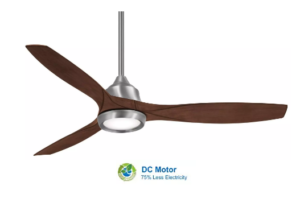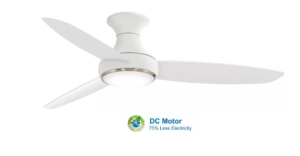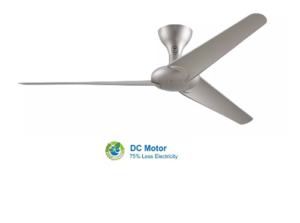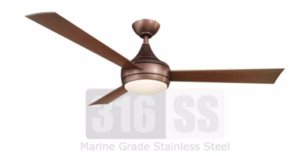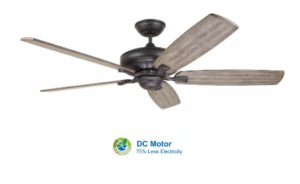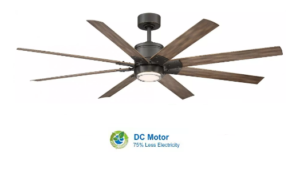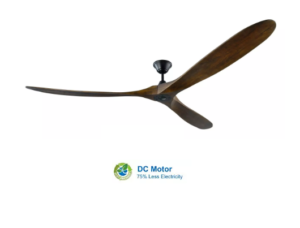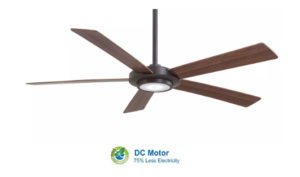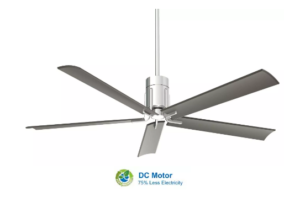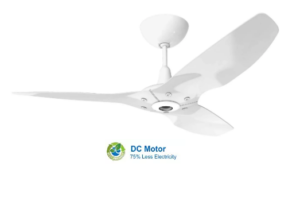Ceilings fans with remote controls are very convenient for modern day living. They are especially nice in bedrooms and living rooms so that you can control it from the comfort of your own bed or couch. We took a deep dive into the different ceiling fans on the market. We compiled the very best ones that come with a remote control. You can also read our detailed and extensive guide to buying a ceiling fan at the bottom.
The Minka Aire Skyhawk is an eco-friendly ceiling fan with solid wooden blades and minimum plastic. The curved blade design produces an airflow of 7284 CFM. This exceptional airflow with a wind speed factor of 3.28 MPH provides instant cooling. The modern and sleek design along with 164 CFM/Watt high efficiency makes it an ideal choice for large indoor spaces.
It comes with a long lasting LED Array rated for 30,000 hours of usage can last 30 times more than an ordinary incandescent bulb. The LED comes with an exceptional 92 CRI to render true colors and 3000k color temperature to mimic natural light. You get a hand-held remote with 6 speed settings and a light dimming feature.
The Minka Aire has the most diverse range of interior décor items for every pocket and preference. Their fans are sleek yet high performing gadgets like the Skyhawk series. If you are looking for energy efficiency and durability in a fan, this 60″ Skyhawk LED Brushed Nickel would be your ideal bet.
The Minka Aire Concept III with remote control is a Wet rated model with an integrated dimmable LED bulb within a white etched opal glass cover. The fan operates by a hand held remote which can operate the light and the three speed settings. This UL Wet rated model is good for wet locations including gazebos, lanais, lattice covered patios or any other outdoor area.
With a large 54” blade span, it cools your room fast. With a reverse function it serves throughout the entire year. The energy-efficient DC motor consumes only 30 watts per hour which is far below than the average of 76 watts/hour.
Minka Aire is the first choice for contemporary yet timeless designs. Its Concept III LED Brushed White model gives that old-school vibe but with an improved performance. Its contemporary design under $400 price tag makes it a good choice for any home decor.
The Fanimation Drone ceiling fan features a unique design with smart features. With its proprietary fansyc technology, this fan is compatible with any smart device. Thus, you can control it via a smartphone app, or voice controls from Google and Alexa. Otherwise, a wall control and a hand held remote control are also available.
We love that it has a timer setting. And, its fresh air mode modulates the fan’s RPM for a more natural breeze. The range of airflow is greater than any average fan with 16 speed settings. As its efficiency is 160 CFM/ Watt (quiet high), you can rest assured of a high performance while keeping the bills in check.
Fanimation fans are popular for home and office decors. The products are budget-friendly and feature multi-functionality. The Drone ceiling fan is no exception either – one of their best sellers indeed.
With a 316 marine grade stainless steel body, the Atlas Donaire is your all-weather outdoor fan. It can withstand any harsh outdoor environments including a direct exposure to rain, snow and sleet. Thus you can install it in your gazebo, lanais, lattice covered patio or any other outdoor area. Its 52” blade span (with 14 degree blade pitch) are virtually rustproof and facilitate a strong air movement.
A convenient hand-held remote controls the integrated dimmable LED light and its 3 speed functions. LEDs come with a light globe for protection and maximum diffusion of light. Its airflow is above average at 6573 CFM for better air distribution.
For the last two decades, the Matthews Fan Company is into creative designs to complement modern homes. Surprisingly, none of their modern and retro designs lack any functional or esthetic feature. In this regard, the Atlas Donaire is one of its most reliable and multi-faceted designs trending for the past six months.
The Emerson Carrera with remote control is a customizable fan for your indoor and outdoor applications. It comes in multiple blade sizes and color options to perfectly match your décor. The light fixtures are also optional depending on your requirements. It has a six speed wall control with independent downlight dimming function to customize your room ambiance. Plus, it comes with a remote you so you have multiple control options.
The fan comes with an energy star qualified eco-DC motor. It consumes three times less electricity than a typical AC motor. As per the company, it consumes only 22 watts per hour thus it saves you a lot on overall energy usage. The airflow is extraordinary at 7929 CFM and it produces enough of a breeze at a 3.57 MPH wind speed factor.
Emerson is a globally renowned fan company known for its best-in-class tech models suitable for any modern decor. Carrera is one of their finest models that users find perfectly suitable for both home and office applications.
The Renegade ceiling fan features a weather-resistant aluminum body to promise high durability. The optional downlight LED comes with 3500k and 2700k LED options to add crisp bluish or softer yellow color to your room.
Modern Forms fans easily connect to your existing home automation systems with smart voice assistants. The fans have energy-saving DC motors to consume 70% less electricity than traditional AC fans. Through a native smart app, it can automatically adjust its speed and light intensity as per your preference. You get a wall and a hand held remote control as well with this ceiling fan.
Fans from Modern Forms complement Smart homes with Wifi and a native mobile application. You receive technologically advanced products at a low price. Its Renegade series fans don’t just look fancy, they perform well too. With an eco-friendly Energy Star qualified DC motor inside, this comes in the bucket list of everyone.
The Monte Carlo Maverick features hand carved solid balsa wood blades to take anyone by surprise. These high-quality durable blades give it an aerodynamic shape and keep it light in weight. The motor rotates at its max 100 RPM (revolutions per minute) to give an astounding 14,784 CFM airflow. As a result, it easily creates heavy air movement and instant cooling across a very large space in just minutes.
The 88” blade span gives a terrific wind speed at 3.34 MPH. Its efficiency rating is extremely good at 569 CFM/ watt (avg 86). Without lights, the motor consumes only 26 watts/hour to serve the purpose without spiking your energy bills. This beast of a fan comes with a remote control for easy use.
The Monte Carlo fans are known for their extraordinary design and value-for-money features. Their Maverick series is a cut above the rest due to their high performance and energy saving design. With a 5-star air quality rating, it is one of the most highly sought after styles in the market.
The Minka Aire Sabot Ceiling Fan comes with medium maple or dark walnut blades that blend with any dacor. Its super efficient DC motor rotates in six different speeds, between 65 to 173 RPM, to deliver four star quality air at 5779 CFM. With this power, you can expect a decent cooling breeze from the Sabot. It comes with a remote so you can control it from the couch.
It also features a single globe light fixture with a 17 watt dimmable LED array to throw lights at 3000K intensity, equivalent to that of a 75 watt incandescent bulb. You get a lifetime limited warranty on its motor which consumes only 33 watts per hour. With a high 175 CFM/watt efficiency, it still comes out to be budget-friendly, especially if you operate more than one such fan simultaneously. The package also includes a 6” downrod to maintain a safe ceiling height with ease.
Minka Aire products are crafted keeping humans and environment in mind. The Sabot in Oil Rubbed Bronze comes with an Eco-friendly DC motor that not only delivers a good performance but also helps you make an environment-friendly decision.
The Minka Aire Clean 60″ LED Ceiling Fan In Polished Nickel ticks all boxes of an ideal indoor fan. Its 6-speed super efficient DC motor coupled with a 60” blade span creates a huge amount of air to keep you cool. It includes a hand held remote control with forward/reverse controls and a full range light dimmer.
It creates a a large volume airflow at 10340 CFM while the average is just about 5755 CFM. Without lights, it consumes only 41 watts per hour. The 250 CFM/watt efficiency rating will keep your energy bills down to a minimum.
Minka Aire is one of the leading fan manufacture companies offering energy saving solutions for residential and commercial purposes. Its Clean LED in Polished Nickel ceiling fan is a great choice for large indoor rooms such as halls and dining rooms.
The Haiku ceiling fan features a UV-C uplight with advanced germicidal ultraviolet technology. It radiates low spectrum ultraviolet light to sterilize indoor air of any harmful pathogen and bacteria.
The large 60” blades rotate at max 177 RPM to create 7957 CFM airflow with ease. Even power failure won’t stop its performance due to its digital inverter motor inside. Besides all the advanced features, its efficient DC motor consumes only 31 watts per hour and delivers air of 5-star quality rating. Even the above-average wind speed factor promises nothing but a strong breeze.
The Big Ass Fans Haiku series features both technology and incredible performance with a promise of maximum energy savings. It won’t fail you in terms of performance, design or durability, even after years of usage.
As an affiliate partner, we may earn from qualifying purchases made on these products.
A Ceiling Fan Buyer’s Guide: Everything To Know When Buying a Ceiling Fan with a remote.
We have a deep love for ceiling fans and live to help others understand these products as well as we do. That is why we took the time to write a ceiling fan buyers’ guide.
Buying a ceiling fan for the first time can be overwhelming. There are many options for with remotes and each fan has different styles, sizes, functionality, blades, and installation steps.
Fortunately for you, we have distilled all of the key variables down into an accessible and digestible guide. You can read this guide if you want an in-depth understanding of ceiling fans or you can skim it if you only want to better understand certain aspects of the fan itself.
This includes how to select a fan to buy, the types and angles of a fan’s blades, the pros and cons of the AC and DC motors that power fans, and how to install the fan on your ceiling. If you follow this guide you can be confident that you are making a well informed buying decision.
We know all things ceiling fans and want to pass on our learnings and insights to help you.
What is a fan with a remote? How are these fans unique or different than other types of fans?
Simply put, ceiling fans with a remote are similar in performance to those fans without remotes. What is different is how you turn the fan on or off and control its speed, lights, and other general settings.
Specifically, a fan with remote control access comes with a hand-held remote control so that you can adjust or alter the fan’s settings without touching the fan itself or a switch in your wall.
Most remote controls look like those you would use for a TV, except simpler. They fit within your hand and have a few buttons to:
- Turn the fan on or power it off
- Adjust the speed of the fan and thus control the air-flow
- Change the direction of the fan’s blades
A ceiling fan with a remote control is easy to use and makes quick fan adjustments hassle free.
This is a particular benefit for those living in climates that change temperature rapidly. Or for people who don’t like to get up but want to change the fan as easily as they can change the television.
What are the benefits of a ceiling fan with a remote?
We know that once you evaluate, select, and install a ceiling fan it will likely remain in place for many years to come. That is because ceiling fans can be heavy, expensive, and labor intensive to install.
A central air conditioning system consumes 3 kiloWatts, which is about 36 cents per hour. Running a fan only runs at 30 Watts, equivalent to only a cent per hour.
Fans with remotes help you adjust your fan’s speed and energy output efficiently. This will save you effort and money.
This makes fans affordable and energy efficient alternatives that many people love as they are good for you, your wallet, and the environment.
Take the time to do research now before buying because the switching costs of changing your mind can be high.
Go through this evaluation check-list so that you better understand the types of motors, blades, installation units, and fans that exist. We encourage you to optimize for:
- Overall quality: in particular the speed of the motor to optimize for cooling efficacy and quietness.
- Aesthetics: in particular ensure that you are happy with how the fan looks, its color, shape, design, and blade count.
- Size: select the right size fan for the room you will be placing it in. Larger rooms require larger fans to create strong air flow.
Selecting the location of a ceiling fan with remote: Inside or Outside
Most ceiling fans are used within the home. Others are for outdoor structures. Before deciding which type of fan to buy, determine where you will place it. Understanding the placement of a ceiling fan will help you select other attributes – like size, speed, and sound – that will enhance your experience with the fan.
Outdoor fans require different electrical strategies and water-proof finishes. Please keep this mind throughout the guide as we largely focus our attention and advice to those people who want to install indoor fans.
If you are using a remote for your outdoor fan, make sure that the control is waterproof as well.
If placing the ceiling fan with remote in an indoor room, measure the size of the room.
Bathrooms tend to be smaller than bedrooms which tend to be smaller than living rooms or kitchens.
Knowing the approximate size of the room in which the fan will be placed is important.
Larger fans are best suited to larger rooms as their blades and motors move greater volumes of air.
Ceiling Fan Size Chart
| Room (in feet) | Cubic Feet/Minute | Fan Size |
| 6′ x 6′ | 3,000 – 4,500 | Shop: 24″ to 36″ |
| 10′ x 10′ | 4,000 – 5,500 | Shop: 37″ to 48″ |
| 12′ x 12′ | 6,200 – 7,500 | Shop: 49″ to 56″ |
| 15′ x 15′ | 7,000 – 9,000 | Shop: 60″ to 72″ |
| Larger | 9,000 – 11,000 | Shop: 80″ to 99″ |
The length of the blade of the fan and the size of the room go hand in hand.
In short, if you have a large room, buy a larger fan. The bigger the fan the better.
The common sizes for ceiling fans are 36, 44 and 52 inches, with the large fans having a blade wingspan of 60 inches.
Of course you can technically go even larger, with the largest recreational home fans having up to 99 inches of wingspan.
99 inches is 8.25 feet. That is a large fan indeed.
Measure the height of the ceiling and allow at least 7 feet and 6 inches of space.
It is wise and safe to place your fan at least 7 feet above your flooring.
Placing a ceiling fan high up protects tall individuals from hitting their head or having their hair caught while the fan is in motion. Fans need to be installed on ceilings and these installation bases take space as well.
An installation base is adjoined to a downrod, which is a simple piece of metal that the fan is connected to and hangs from.
The average American ceiling height today is 9 feet (2.7432 meters). This means that the average room can support a fan but with a shorter downrod.
If you have average sized ceilings you can afford to install no more than 1 foot and 6 inch downrods.
How to measure downrods and base mounts
A ceiling fan is composed of fan blades, a downrod, and an installation base.
The installation base attaches to the ceiling. The downrod connects to the base. And the fan itself hangs from the downrod.
Per the measurements mentioned above, the fan must be at least 7 feet and 6 inches above the ground if you have a standard 9 foot ceiling.
There is one exception: fans placed above beds, where you will not walk, require less height.
Many people enjoy selecting the fit and finish of the downrod as these pieces of metal or plastic come in different colors, shapes, and sizes and compliment the overall fan’s aesthetic.
As a general rule, more expensive ceiling fans enable you to have longer and more customizable downrods. The downdrods tend to be longer – between 6 and 18 inches.
This is for functionality and aesthetics. Cheaper ceiling fans sometimes have very short – or almost nonexistent downrods – because the base and the fan are fused together.
Design and Look: What to Think About a fan with remote controls general aesthetics
A hugely important aspect of a ceiling fan is what it looks like. If you see the fan while lying in bed or while in your living room you will want it to look great.
The base and downrod are not nearly as important as the blades for how a fan looks in a room.
Blades come in different cuts, lengths, seizes, finishes, colors and of course quantities.
Likewise the remote control can come in different sizes and colors. Usually the controller is white or black and has a few very simple buttons to activate the fan and control the fan’s settings.
How many blades should a fan with a remote have?
At a minimum, a ceiling fan will have two blades though four or five are certainly more common.
A two blade fan can be made of one long piece of metal connected at the mid-point or two distinct blades.
One type of ceiling fan, called a windmill fan, can have upwards of 20 blades packed tightly together.
Blades add functionality and impact the air flow.
When you look at a fan that is turned on, the blades are hard to see. When the fan is stationary, however, the design and color of the blades will need to align with your preferences for style and decor.
Fans with four to six blades produce a lower pitch, softer volume noise output. Three blade fans use the air surrounding the fan most efficiently and require the least effort to clean as you have fewer blades and surface area to collect dust.
Windmill fans, always popular in kid’s rooms, have the most surface area of blades. This increases the effort to clean and dust these fans.
It is less common to allow children to control fans via a remote as opposed to manually. As a result, it is more common to see standard fans have remote controls as opposed to windmill fans. Nevertheless, these do exist.
The color, material, and quantity of the blades impact how the fan looks and performs.
Another subtle variable is at play too: the angles of those blades. If the blades are too flat, they won’t whisk through the air and create air flows. We highly advise blades with angles between 12 and 14 degrees.
Nearly all of the fans we provide you here have angles in that range for optimal air circulation and air flow efficacy.
More than a fan: how a fan with a remote provides lighting, symmetry, and aesthetic benefits.
Some people buy ceiling fans simply to cool or heat a room. Others buy ceiling fans because they can be elegant and add character to a home. Some fans have lights and others do not.
If you are going to place your fan in the center of a room – for example, your living room – you might do so at the expense of a central lighting system.
For this reason, adding lights to fans is popular. If you add lights you will want to also consider how easy it is to change the bulbs, especially if the fan is very high above your floor.
LED, Halogen, and Fluorescent lighting options are available on all fans that have integrated lighting.
Control Your Environment: Noise and Air Flow
Fans without lights produce two types of energy outputs when they are on: noise and air-flow. Both will impact your experience with the fan. Fans with lights also produce illumination as an energy output.
Firstly, noise is a byproduct of any fan. The rotation of the blades and the motor can cause distinct sounds. Larger motors produce more power and, as a result, can generate more noise.
The good news is that noise can be mitigated.
Motors that are built from higher quality and durable screws, armature, bearings, windings, and rotors are more expensive.
Cheaper fans have motors that usually produce more noise as a byproduct.
If you want a quieter fan, buy a more expensive one. You won’t regret it.
Please pay particular attention to this when considering which type of fan you will place in different rooms in your home. If you are considering a bedroom ceiling fan, it is prudent to optimize for minimal sound.
People tend to care less about noise when a fan is in a garage or bathroom.
The second type of energy output is air-flow.
Fans can not only cool rooms, they can also heat rooms and reduce air moisture.
They substitute central cooling or work in conjunction with air conditioning.
Fans do not lower air temperatures. They produce air flows and circulation which can in turn create the effect of a windchill.
The wind chill temperature is how cold people feel. The air flow, which leads to evaporative cooling (deratification), is generated by the ceiling fan.
If you are using a fan for general room cooling, you will want a fan that accelerates the heat loss from exposed skin.
Put simply, you will want a fan that generates significant air-flows point downwards and towards the center of the room.
A remote control is your perfect assistant for managing air flow without getting up. You can stay seated or in bed and change the fan’s speed and air flow. A remote controlled fan is a deligh in the bedroom.
Air Flow Deep Dive: Cubic Feet per Minute
Air flow is the volume of air that is produced by the fan.
The most common way to measure air flow is Cubic Feet per Minute (or CFM).
All of the fans we review have a CFM rating so that you can easily compare how much air that each fan produces.
The average CFM is around 5,000.
For nearly all non-industrial use-cases, like your home bedroom, kitchen, living room, or garage, a CFM of 6,000-7,000 is optimal.
At this rate you will be left feeling cooler without greatly enhancing your energy bill or having papers strewn all over the place from the powerful wind currents that larger fans produce.
You might also see a measurement similar to CFM which is air (or wind) Miles Per Hour.
Much like measuring the speed at which one drives, a fan can have its air speed measured too.
Nearly all fans produce between 3 and 5 Mile Per Hour air flows. Naturally, the higher the MPH, the stronger the air flows.
Controlling Your Fan and Your Energy Output for Efficiency
Mobile apps and the internet have changed how we communicate, manage, and control various technologies.
Ceiling fans are no exception.
Ceiling fans are well suited for management by a digital switch, remote, or mobile app because you can power the fans on or off (or even alter the speed) from afar.
A connected fan is controlled via a remote control or smartphone. In contrast, less expensive and simpler fans are controlled via a manual switch.
Many fans support both physical switches and remote control access. In case you lose your remote or it runs out of battery, you can still turn your fan on or off.
If you plan on installing your fan over 9 feet above the ground, you should buy a fan that can be controlled digitally.
All ceiling fans can create air-flows bi-direactionally.
Usually a simple switch exists on the fan’s motor or external base that enables you to change the direction in which the blades rotate.
Changing the directional air propulsion is critical during the winter months.
Rather than have air convected from the center of the room for cooling, you will want air to move from the blades horizontally down through the walls.
Lateral air-flow is used for heating rooms and maintaining central warmth while reducing your energy bill.
Choosing the right ceiling fan direction
How you control your fan is correlated with how much energy your fan uses. Will you leave it running all the time? Or will you use smart logic to power it down after a certain amount of time?
If the latter, know that that performance is harder to achieve with a remote controlled fan. That is because you usually can’t program the fan and need to adjust it digitally.
We have gone above and beyond to think about fans not just as cooling mechanisms but as a tool that can help you save money while lowering your ecological footprint. These efforts will, most importantly, save you money.
Let me explain further.
When you use central cooling or air conditioners, you are physically reducing the temperature in a room.
An air conditioner sucks air into its ducts through a vent. This air cools the gas in the evaporator and as the heat is removed from the air, it is cooled. Cool air then flows into your room.
This process is energy intensive and expensive.
In contrast, a ceiling fan does not cool the room or remove heat. Rather, it moves air around which creates the feeling of cooling. Actual cooling is not occurring. Less energy out means less energy in. And in total this means a lower energy bill.
What A Fan with a Remote Looks Like To You and Others
This guide provides ample information pertaining to how a ceiling fan works and things you should be aware of before buying one or many fans for your home.
What we have not discussed in great depth is how a fan looks and the importance of design aesthetics.
A fan will need to fit aesthetically into your room and, as a result, you should think about material (wood, metal, plastic), color, and design patterns. Some questions to reflect on:
- Is the room light or dark? Is it naturally well lit or does it require lots of electrical light?
If your ceiling fan is going in the center of your living room, for example, you will likely want a fan with built-in lighting. This is because many living rooms have existing fixture hardware and wiring.
- Do you want a smart fan that connects with your digital applications and services (Google Home, Nest Apple Siri, Amazon Alexa)?
If you control other aspects of your home – like the temperature and humidity – via smart apps, you might want to add a ceiling fan as another connected Internet of Things device. Likewise if you have high ceilings and plan to install a fan that you can’t easily reach by hand.
Smart fans can be controlled via your phone, tablet, or voice, and these controls will make turning them on or off easier.
- Do you want a windmill fan?
Windmill fans are harder to clean (more blades means more surface area for dust to land and accumulate). On the other hand, windmill fans are quiet and elegant.
This type of fan is also hugely popular in kids rooms and living rooms.
The windmill fans pay homage to an older design aesthetic.
While this fan is not modern chic it goes very well in rooms with wooden floors or darker walls because it is made of simple plastic or wood finishes, glass fiber reinforced polyester, and thin pulp-plastic infused blades.
- What color do you want the fan? What style finish do you want? What color do you want the remote?
Sleek and minimalist fans have fewer blades. These fans, made of lightweight metal, have universal white, grey, or black finishes.
Many remotes fit in the palm of your hand and are black or weight. See how the remotes are charged. Some require batteries and other USB connections. While both types are equally easy to charge ensure to select the one that best aligns with your needs.
Where to buy a ceiling fan with a remote?
Ceiling fans are heavy and can be difficult to fit in a car or to transport yourself unless you have a large vehicle or flat-bed truck. Given this, it makes a lot of sense to have your fan shipped to you so that it arrives ready for home assembly.
You can self-install a ceiling fan with a remote. This work requires moderate technical skills and physical strength. This is because you will need to install not only the fan (the blades) but you will need to connect the fan’s base to the ceiling and its electrical fixture hardware and wiring.
How much do ceiling fans with remotes cost? What impacts the price of this type of fan?
Ceiling fans witty remote controls range in price from $125 on the cheap-end to over $2,000 on the high-end. There are several reasons why the range in price is so large.
A ceiling fan, made of plastic instead of more durable wood or metal, is cheaper.
Additionally, less expensive fans have weaker motors. This means that they are capable of producing less air flow or have smaller Cubic Feet per Minute scores.
More expensive fans are akin to those you would experience at a resort or high end hotel. A ceiling fan over $1,200 will likely come packed with high tech solutions built-in.
These fans will enable you to:
- Program the fan based on motion, temperature, or humidity.
- Turn the fan on or off based on preset logic or rules for maximum physical comfort.
- Enjoy very efficient and quiet DC motors that have multi-decade support and lifetime expectations.
Moreover, these pricer fans come with app based (smart phone, iPad) mobile management and remote controls.
It is common for expensive ceiling fans to come with mount options so that you can install a panel adjacent to your light switch. These wall mounts enable you to control not only the fan (on/off) but also the fan speed and direction.
Cheaper fans do not come with these in depth level of controls or sophisticated management features.
And that is ok. Simplicity might be what you crave.
Cheaper fans cool rooms as well and can be easily turned on/off with pull chains.
Less expensive fans (in the $100-$300 price point) still come with energy-efficient dimmable lightbulbs.
AC vs DC fans: Understanding a fan’s power source
Most inexpensive fans leverage AC motors.
Although AC motors are more powerful than DC motors, they typically are less efficient and are not as good at using their energy output.
This can cause additional noise (thereby making it harder to sleep if that fan is in your bedroom).
When buying a fan, please take a moment to see the Power Source listed in the fan’s essential product information that all suppliers provide. If you buy a fan with an AC motor, it will be louder.
As a result, we highly advise buying a DC powered fan if you will be sleeping near it.
AC motors are durable and longer lasting. While this might seem positive, DC motors are better (and therefore more costly).
DC motors are simpler to install into the fan’s base, have high startup power, and have a faster response time.
This means that time will be shortened from when you switch the “on” button to when the fan is accelerating to cool your room.
Although more expensive, ceiling fans with DC motors consume 70% less power which will enable you to save money over time as you pay less to power them.
Where to place the ceiling fan: voltage and flush mounting
Many people place their ceiling fans in the center of a room or above a bed. This is to maximize comfort and the impact of the fan’s air flows.
A centrally placed ceiling fan also creates room symmetry.
Voltage is the pressure from an electrical circuit’s power, and the most common electrical outlet in any home is a 110 volt. If you live in the United States, you will need to select a fan that complies with this voltage limit.
Luckily for you, nearly all off-the-shelf ceiling fans support this standard.
When installing a ceiling fan you will need to get a few things absolutely right. We have done this many times for ourselves, our family, friends, and of course our clients.
Firstly, some ceiling fans support flush mount integrations. Flush mount fans sit directly against the ceiling and point downwards. These fans are typically useful for cooling a small room.
Not all ceiling fans are flush mountable.
This means that they will hang lower from the ceiling. If you buy a fan that cannot be flush mounted, please ensure that the lower point of the fan is at least 7 feet and six inches from the ground.
Additionally, ensure that the weight bearing load of the ceiling can support the fan.
Similar to voltage, this should be routine in many homes.
But it is worth investigating because you don’t want to buy a fan just to see it unable to stay upright.
For most fans that we review and see our clients deploy, a ceiling must be able to support approximately 35 pounds of downward pressure.
Buyer’s Guide Summary: Bringing It All Together
Buying a ceiling fan with a remote control for the first time does not need to be overwhelming.
Simply follow this guide to evaluate and buy the fan that fits best in your room and adds the most value in your life.
Don’t get too bogged down in the details. If nothing else, pick a fan that looks great, fits well within your room, and that is priced according to your budget. Ensure you understand how the remote works, and you should be good to go.
If the fan is going into your bedroom, it is worth spending a bit more for a quitter product – you won’t regret it.


